Analysis of The Honda Company: Knowledge Management & Supply Chain IT
VerifiedAdded on 2023/06/04
|19
|4522
|241
Report
AI Summary
This report provides an analysis of The Honda Company, focusing on knowledge management and the role of information technology in its supply chain. It examines the company's approach to knowledge as possession and knowledge as practice, referencing Nonaka's SECI model. The report discusses collaboration, conflict resolution strategies, and the implementation of lean management principles within Honda. Furthermore, it explores how information technology facilitates data delivery and enhances sustainability in the company's global supply network. The analysis concludes that effective knowledge management and strategic use of IT are crucial for Honda's competitive advantage. Discover more solved assignments and study resources on Desklib.
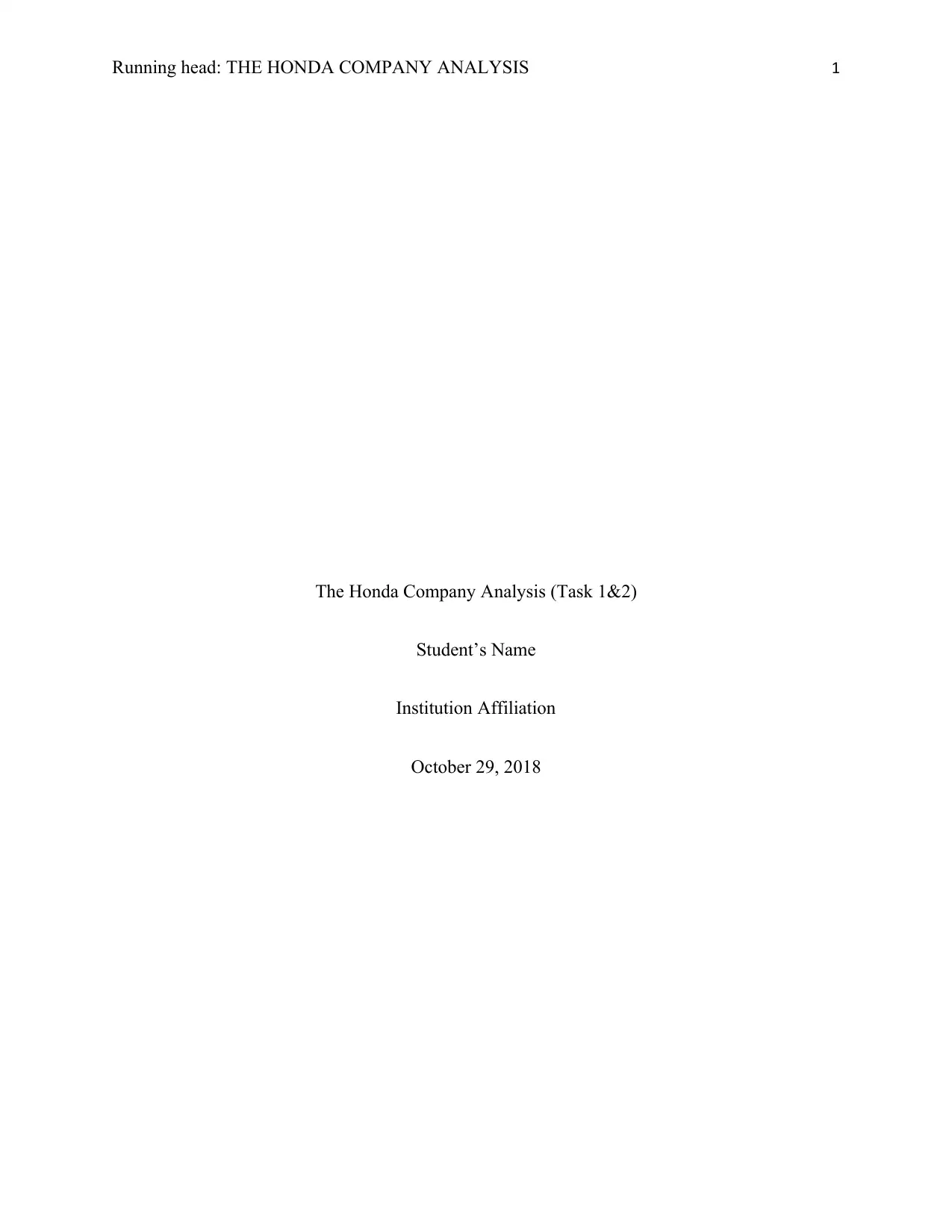
Running head: THE HONDA COMPANY ANALYSIS 1
The Honda Company Analysis (Task 1&2)
Student’s Name
Institution Affiliation
October 29, 2018
The Honda Company Analysis (Task 1&2)
Student’s Name
Institution Affiliation
October 29, 2018
Paraphrase This Document
Need a fresh take? Get an instant paraphrase of this document with our AI Paraphraser
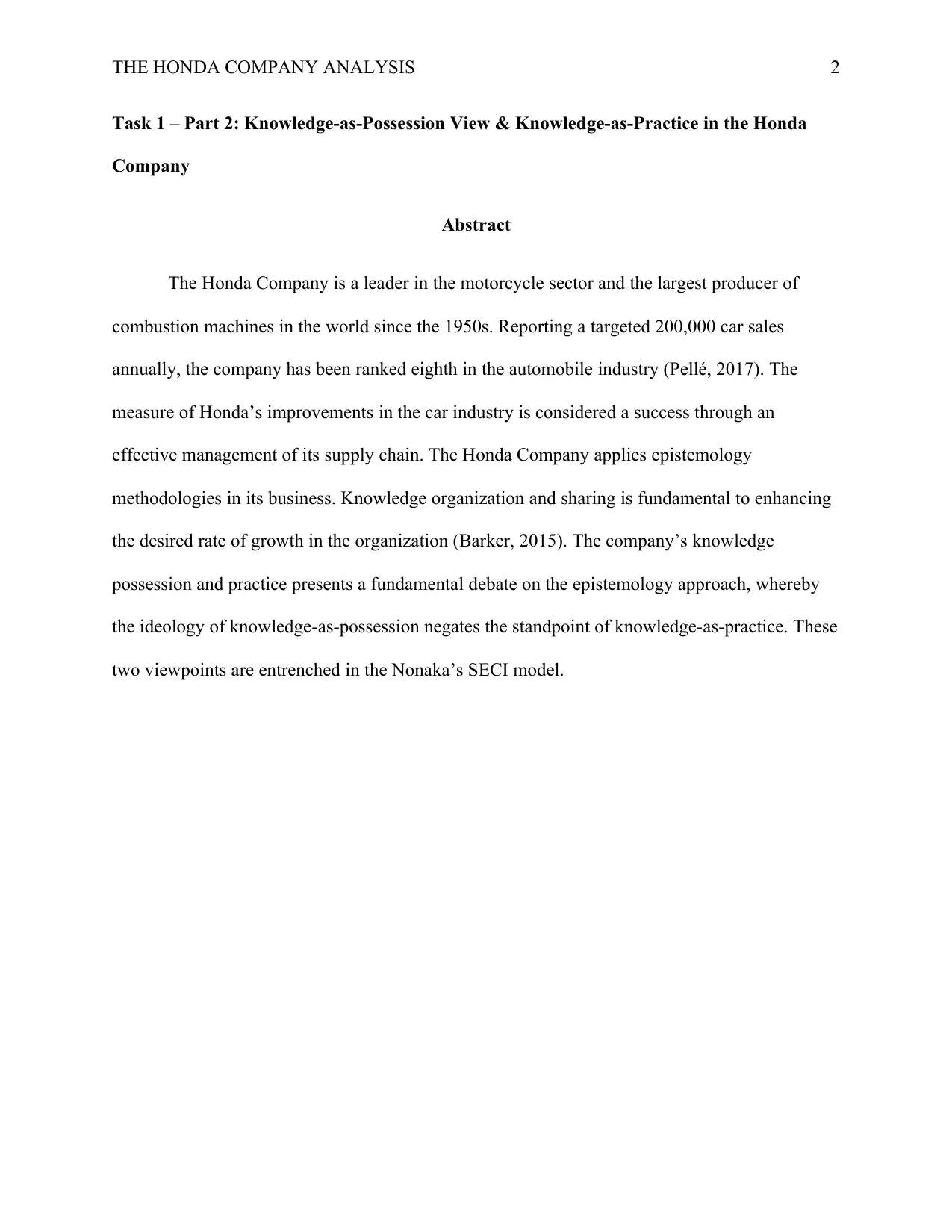
THE HONDA COMPANY ANALYSIS 2
Task 1 – Part 2: Knowledge-as-Possession View & Knowledge-as-Practice in the Honda
Company
Abstract
The Honda Company is a leader in the motorcycle sector and the largest producer of
combustion machines in the world since the 1950s. Reporting a targeted 200,000 car sales
annually, the company has been ranked eighth in the automobile industry (Pellé, 2017). The
measure of Honda’s improvements in the car industry is considered a success through an
effective management of its supply chain. The Honda Company applies epistemology
methodologies in its business. Knowledge organization and sharing is fundamental to enhancing
the desired rate of growth in the organization (Barker, 2015). The company’s knowledge
possession and practice presents a fundamental debate on the epistemology approach, whereby
the ideology of knowledge-as-possession negates the standpoint of knowledge-as-practice. These
two viewpoints are entrenched in the Nonaka’s SECI model.
Task 1 – Part 2: Knowledge-as-Possession View & Knowledge-as-Practice in the Honda
Company
Abstract
The Honda Company is a leader in the motorcycle sector and the largest producer of
combustion machines in the world since the 1950s. Reporting a targeted 200,000 car sales
annually, the company has been ranked eighth in the automobile industry (Pellé, 2017). The
measure of Honda’s improvements in the car industry is considered a success through an
effective management of its supply chain. The Honda Company applies epistemology
methodologies in its business. Knowledge organization and sharing is fundamental to enhancing
the desired rate of growth in the organization (Barker, 2015). The company’s knowledge
possession and practice presents a fundamental debate on the epistemology approach, whereby
the ideology of knowledge-as-possession negates the standpoint of knowledge-as-practice. These
two viewpoints are entrenched in the Nonaka’s SECI model.
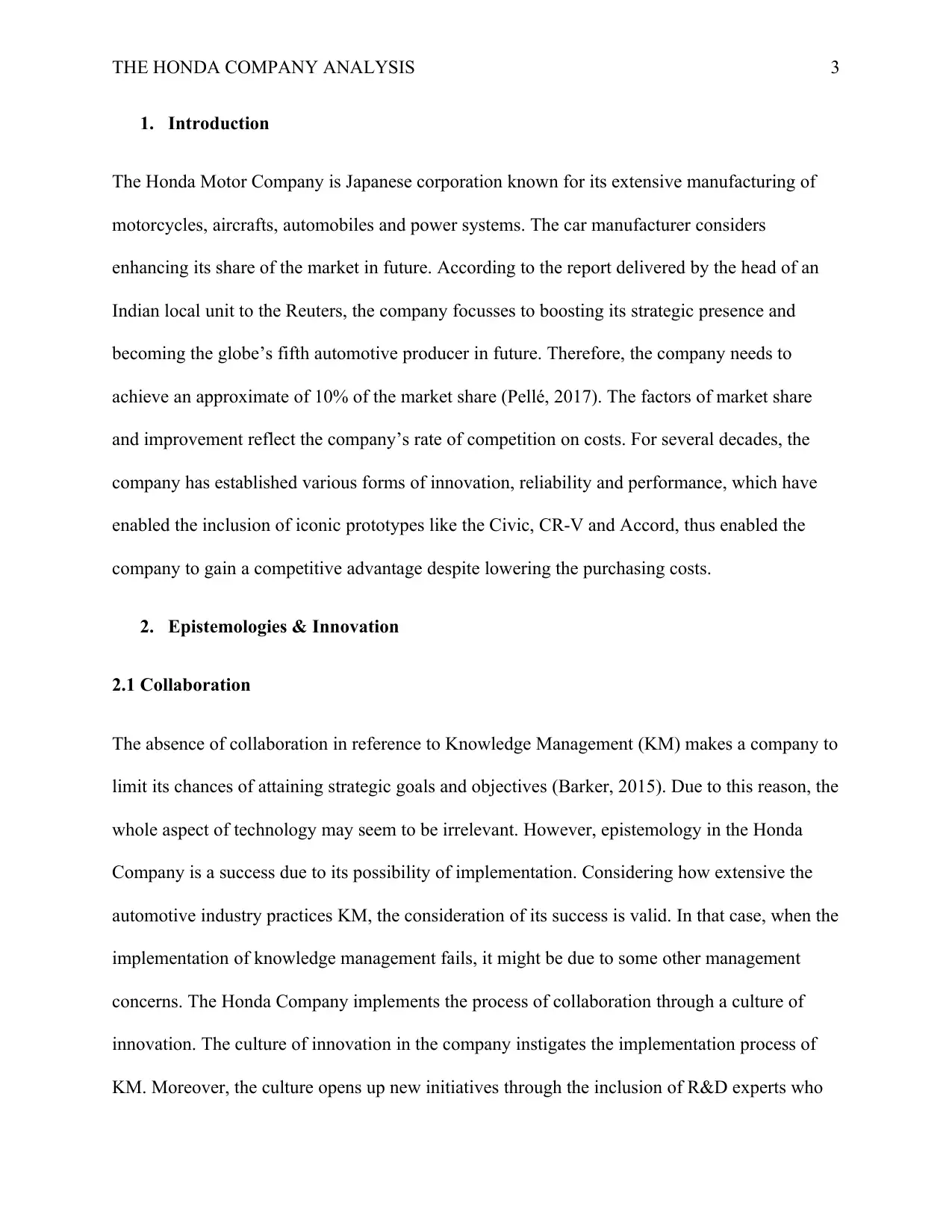
THE HONDA COMPANY ANALYSIS 3
1. Introduction
The Honda Motor Company is Japanese corporation known for its extensive manufacturing of
motorcycles, aircrafts, automobiles and power systems. The car manufacturer considers
enhancing its share of the market in future. According to the report delivered by the head of an
Indian local unit to the Reuters, the company focusses to boosting its strategic presence and
becoming the globe’s fifth automotive producer in future. Therefore, the company needs to
achieve an approximate of 10% of the market share (Pellé, 2017). The factors of market share
and improvement reflect the company’s rate of competition on costs. For several decades, the
company has established various forms of innovation, reliability and performance, which have
enabled the inclusion of iconic prototypes like the Civic, CR-V and Accord, thus enabled the
company to gain a competitive advantage despite lowering the purchasing costs.
2. Epistemologies & Innovation
2.1 Collaboration
The absence of collaboration in reference to Knowledge Management (KM) makes a company to
limit its chances of attaining strategic goals and objectives (Barker, 2015). Due to this reason, the
whole aspect of technology may seem to be irrelevant. However, epistemology in the Honda
Company is a success due to its possibility of implementation. Considering how extensive the
automotive industry practices KM, the consideration of its success is valid. In that case, when the
implementation of knowledge management fails, it might be due to some other management
concerns. The Honda Company implements the process of collaboration through a culture of
innovation. The culture of innovation in the company instigates the implementation process of
KM. Moreover, the culture opens up new initiatives through the inclusion of R&D experts who
1. Introduction
The Honda Motor Company is Japanese corporation known for its extensive manufacturing of
motorcycles, aircrafts, automobiles and power systems. The car manufacturer considers
enhancing its share of the market in future. According to the report delivered by the head of an
Indian local unit to the Reuters, the company focusses to boosting its strategic presence and
becoming the globe’s fifth automotive producer in future. Therefore, the company needs to
achieve an approximate of 10% of the market share (Pellé, 2017). The factors of market share
and improvement reflect the company’s rate of competition on costs. For several decades, the
company has established various forms of innovation, reliability and performance, which have
enabled the inclusion of iconic prototypes like the Civic, CR-V and Accord, thus enabled the
company to gain a competitive advantage despite lowering the purchasing costs.
2. Epistemologies & Innovation
2.1 Collaboration
The absence of collaboration in reference to Knowledge Management (KM) makes a company to
limit its chances of attaining strategic goals and objectives (Barker, 2015). Due to this reason, the
whole aspect of technology may seem to be irrelevant. However, epistemology in the Honda
Company is a success due to its possibility of implementation. Considering how extensive the
automotive industry practices KM, the consideration of its success is valid. In that case, when the
implementation of knowledge management fails, it might be due to some other management
concerns. The Honda Company implements the process of collaboration through a culture of
innovation. The culture of innovation in the company instigates the implementation process of
KM. Moreover, the culture opens up new initiatives through the inclusion of R&D experts who
⊘ This is a preview!⊘
Do you want full access?
Subscribe today to unlock all pages.

Trusted by 1+ million students worldwide
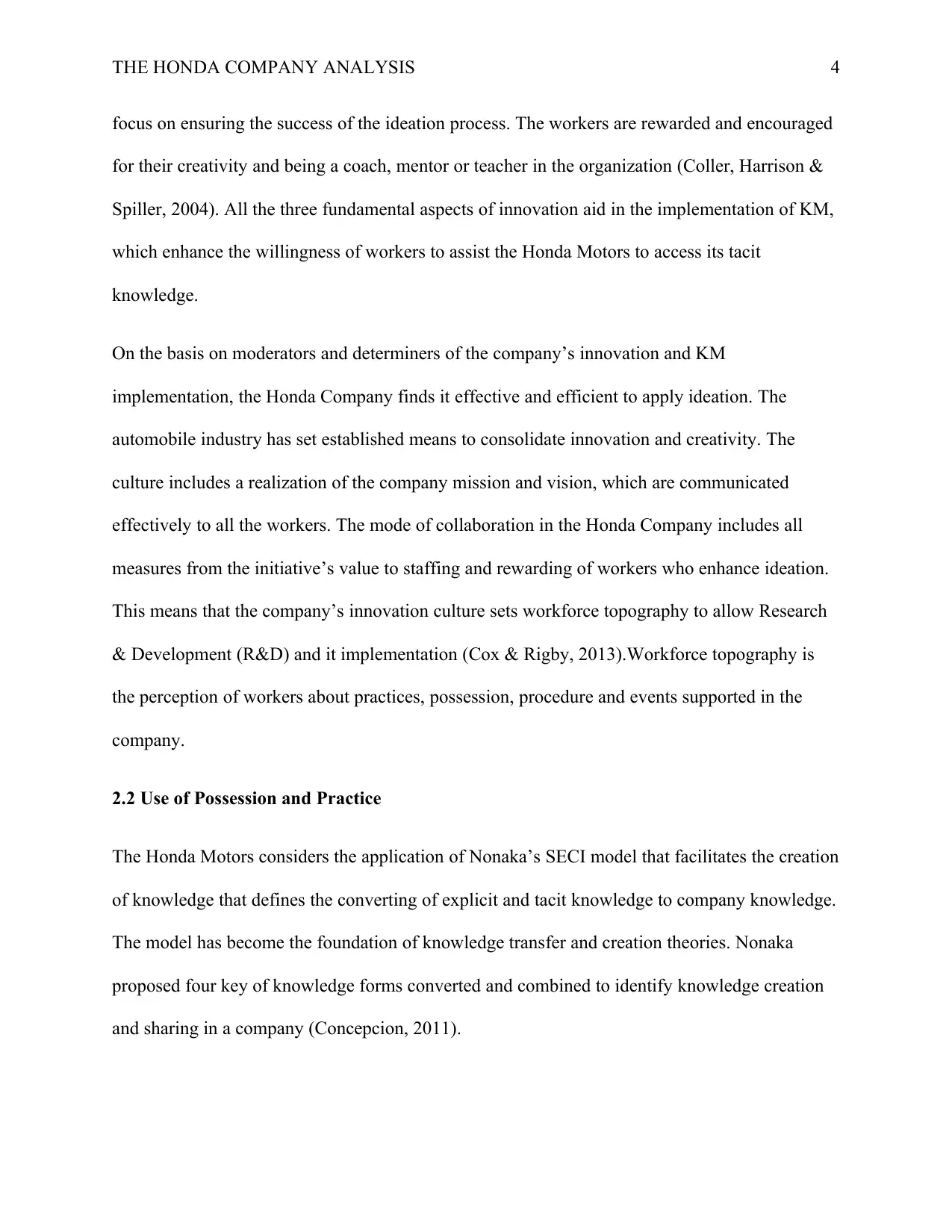
THE HONDA COMPANY ANALYSIS 4
focus on ensuring the success of the ideation process. The workers are rewarded and encouraged
for their creativity and being a coach, mentor or teacher in the organization (Coller, Harrison &
Spiller, 2004). All the three fundamental aspects of innovation aid in the implementation of KM,
which enhance the willingness of workers to assist the Honda Motors to access its tacit
knowledge.
On the basis on moderators and determiners of the company’s innovation and KM
implementation, the Honda Company finds it effective and efficient to apply ideation. The
automobile industry has set established means to consolidate innovation and creativity. The
culture includes a realization of the company mission and vision, which are communicated
effectively to all the workers. The mode of collaboration in the Honda Company includes all
measures from the initiative’s value to staffing and rewarding of workers who enhance ideation.
This means that the company’s innovation culture sets workforce topography to allow Research
& Development (R&D) and it implementation (Cox & Rigby, 2013).Workforce topography is
the perception of workers about practices, possession, procedure and events supported in the
company.
2.2 Use of Possession and Practice
The Honda Motors considers the application of Nonaka’s SECI model that facilitates the creation
of knowledge that defines the converting of explicit and tacit knowledge to company knowledge.
The model has become the foundation of knowledge transfer and creation theories. Nonaka
proposed four key of knowledge forms converted and combined to identify knowledge creation
and sharing in a company (Concepcion, 2011).
focus on ensuring the success of the ideation process. The workers are rewarded and encouraged
for their creativity and being a coach, mentor or teacher in the organization (Coller, Harrison &
Spiller, 2004). All the three fundamental aspects of innovation aid in the implementation of KM,
which enhance the willingness of workers to assist the Honda Motors to access its tacit
knowledge.
On the basis on moderators and determiners of the company’s innovation and KM
implementation, the Honda Company finds it effective and efficient to apply ideation. The
automobile industry has set established means to consolidate innovation and creativity. The
culture includes a realization of the company mission and vision, which are communicated
effectively to all the workers. The mode of collaboration in the Honda Company includes all
measures from the initiative’s value to staffing and rewarding of workers who enhance ideation.
This means that the company’s innovation culture sets workforce topography to allow Research
& Development (R&D) and it implementation (Cox & Rigby, 2013).Workforce topography is
the perception of workers about practices, possession, procedure and events supported in the
company.
2.2 Use of Possession and Practice
The Honda Motors considers the application of Nonaka’s SECI model that facilitates the creation
of knowledge that defines the converting of explicit and tacit knowledge to company knowledge.
The model has become the foundation of knowledge transfer and creation theories. Nonaka
proposed four key of knowledge forms converted and combined to identify knowledge creation
and sharing in a company (Concepcion, 2011).
Paraphrase This Document
Need a fresh take? Get an instant paraphrase of this document with our AI Paraphraser
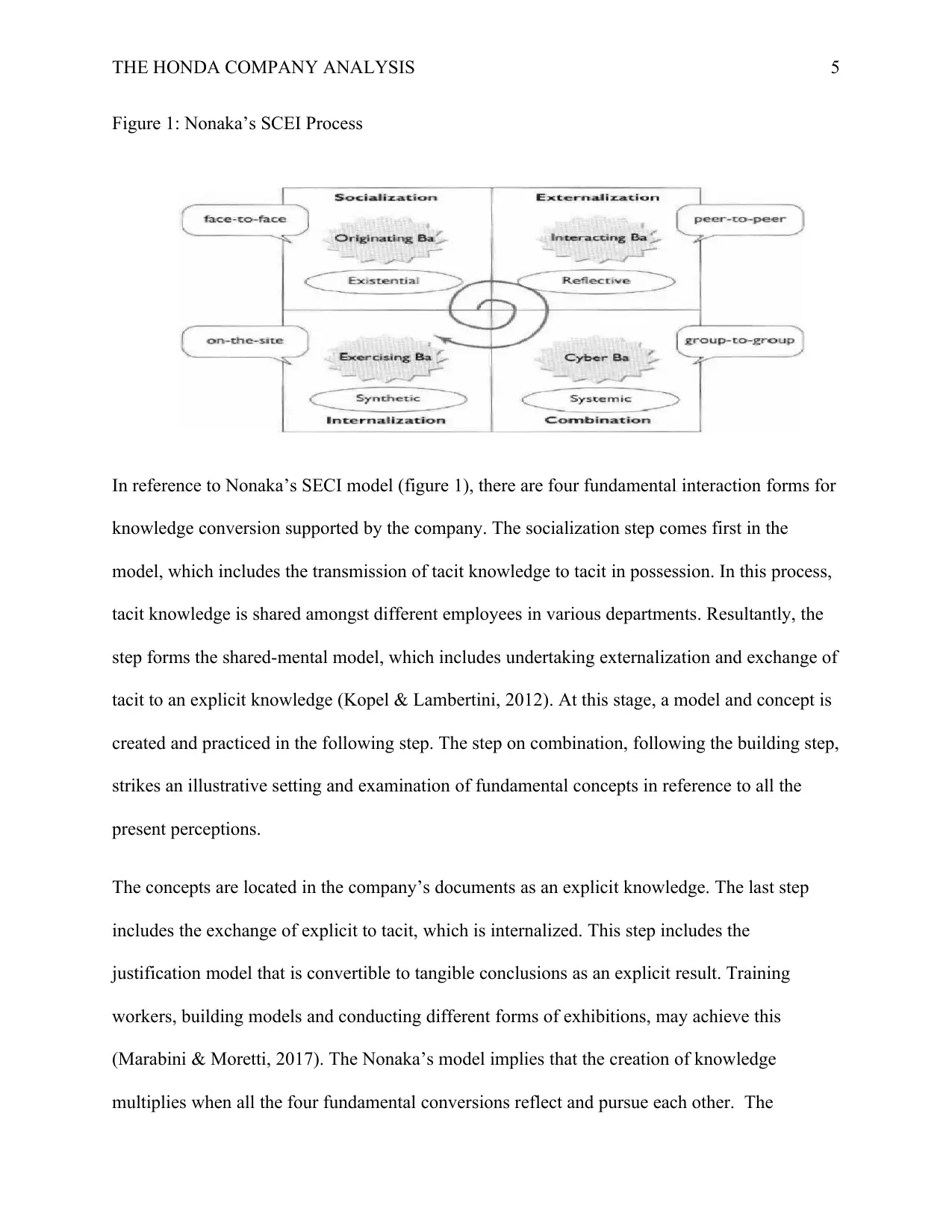
THE HONDA COMPANY ANALYSIS 5
Figure 1: Nonaka’s SCEI Process
In reference to Nonaka’s SECI model (figure 1), there are four fundamental interaction forms for
knowledge conversion supported by the company. The socialization step comes first in the
model, which includes the transmission of tacit knowledge to tacit in possession. In this process,
tacit knowledge is shared amongst different employees in various departments. Resultantly, the
step forms the shared-mental model, which includes undertaking externalization and exchange of
tacit to an explicit knowledge (Kopel & Lambertini, 2012). At this stage, a model and concept is
created and practiced in the following step. The step on combination, following the building step,
strikes an illustrative setting and examination of fundamental concepts in reference to all the
present perceptions.
The concepts are located in the company’s documents as an explicit knowledge. The last step
includes the exchange of explicit to tacit, which is internalized. This step includes the
justification model that is convertible to tangible conclusions as an explicit result. Training
workers, building models and conducting different forms of exhibitions, may achieve this
(Marabini & Moretti, 2017). The Nonaka’s model implies that the creation of knowledge
multiplies when all the four fundamental conversions reflect and pursue each other. The
Figure 1: Nonaka’s SCEI Process
In reference to Nonaka’s SECI model (figure 1), there are four fundamental interaction forms for
knowledge conversion supported by the company. The socialization step comes first in the
model, which includes the transmission of tacit knowledge to tacit in possession. In this process,
tacit knowledge is shared amongst different employees in various departments. Resultantly, the
step forms the shared-mental model, which includes undertaking externalization and exchange of
tacit to an explicit knowledge (Kopel & Lambertini, 2012). At this stage, a model and concept is
created and practiced in the following step. The step on combination, following the building step,
strikes an illustrative setting and examination of fundamental concepts in reference to all the
present perceptions.
The concepts are located in the company’s documents as an explicit knowledge. The last step
includes the exchange of explicit to tacit, which is internalized. This step includes the
justification model that is convertible to tangible conclusions as an explicit result. Training
workers, building models and conducting different forms of exhibitions, may achieve this
(Marabini & Moretti, 2017). The Nonaka’s model implies that the creation of knowledge
multiplies when all the four fundamental conversions reflect and pursue each other. The
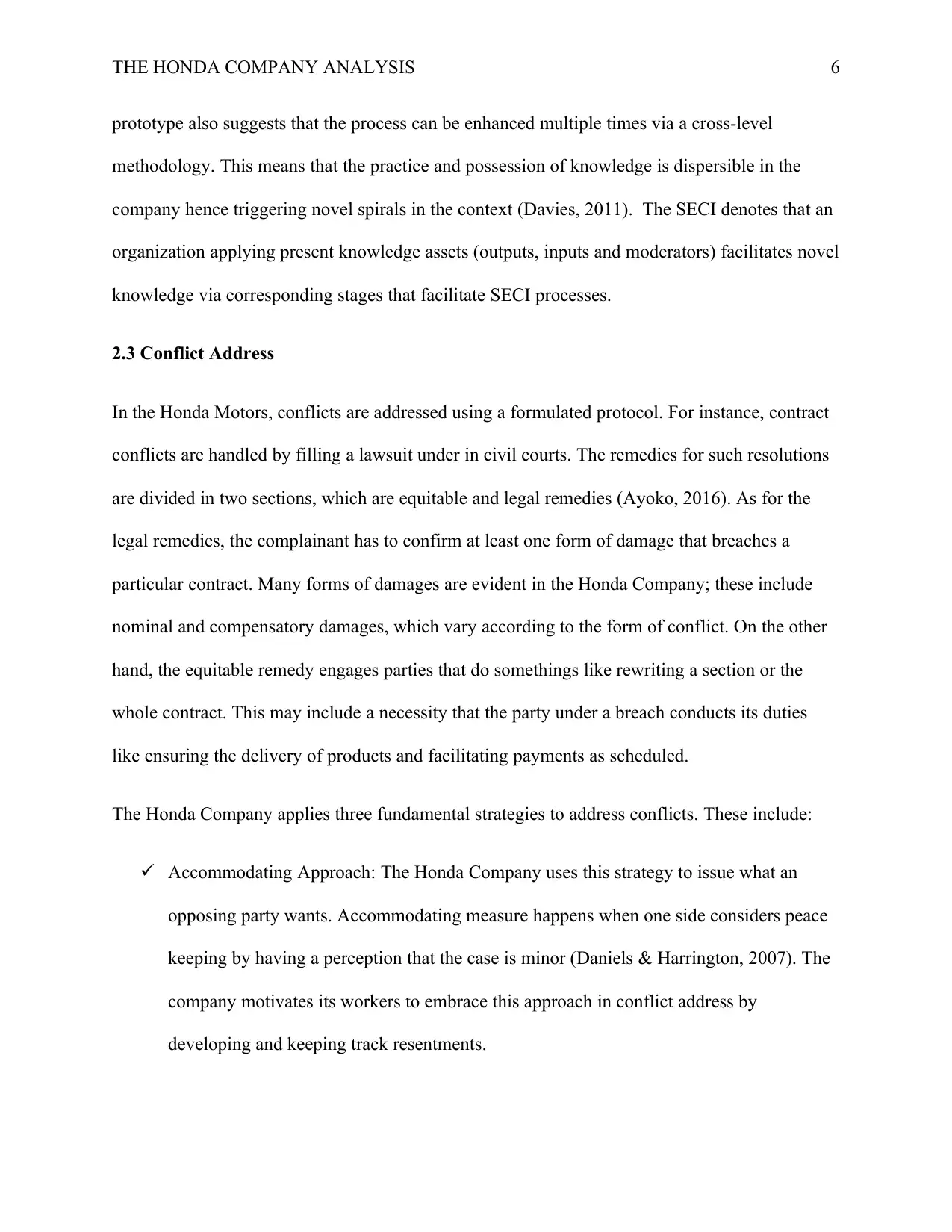
THE HONDA COMPANY ANALYSIS 6
prototype also suggests that the process can be enhanced multiple times via a cross-level
methodology. This means that the practice and possession of knowledge is dispersible in the
company hence triggering novel spirals in the context (Davies, 2011). The SECI denotes that an
organization applying present knowledge assets (outputs, inputs and moderators) facilitates novel
knowledge via corresponding stages that facilitate SECI processes.
2.3 Conflict Address
In the Honda Motors, conflicts are addressed using a formulated protocol. For instance, contract
conflicts are handled by filling a lawsuit under in civil courts. The remedies for such resolutions
are divided in two sections, which are equitable and legal remedies (Ayoko, 2016). As for the
legal remedies, the complainant has to confirm at least one form of damage that breaches a
particular contract. Many forms of damages are evident in the Honda Company; these include
nominal and compensatory damages, which vary according to the form of conflict. On the other
hand, the equitable remedy engages parties that do somethings like rewriting a section or the
whole contract. This may include a necessity that the party under a breach conducts its duties
like ensuring the delivery of products and facilitating payments as scheduled.
The Honda Company applies three fundamental strategies to address conflicts. These include:
Accommodating Approach: The Honda Company uses this strategy to issue what an
opposing party wants. Accommodating measure happens when one side considers peace
keeping by having a perception that the case is minor (Daniels & Harrington, 2007). The
company motivates its workers to embrace this approach in conflict address by
developing and keeping track resentments.
prototype also suggests that the process can be enhanced multiple times via a cross-level
methodology. This means that the practice and possession of knowledge is dispersible in the
company hence triggering novel spirals in the context (Davies, 2011). The SECI denotes that an
organization applying present knowledge assets (outputs, inputs and moderators) facilitates novel
knowledge via corresponding stages that facilitate SECI processes.
2.3 Conflict Address
In the Honda Motors, conflicts are addressed using a formulated protocol. For instance, contract
conflicts are handled by filling a lawsuit under in civil courts. The remedies for such resolutions
are divided in two sections, which are equitable and legal remedies (Ayoko, 2016). As for the
legal remedies, the complainant has to confirm at least one form of damage that breaches a
particular contract. Many forms of damages are evident in the Honda Company; these include
nominal and compensatory damages, which vary according to the form of conflict. On the other
hand, the equitable remedy engages parties that do somethings like rewriting a section or the
whole contract. This may include a necessity that the party under a breach conducts its duties
like ensuring the delivery of products and facilitating payments as scheduled.
The Honda Company applies three fundamental strategies to address conflicts. These include:
Accommodating Approach: The Honda Company uses this strategy to issue what an
opposing party wants. Accommodating measure happens when one side considers peace
keeping by having a perception that the case is minor (Daniels & Harrington, 2007). The
company motivates its workers to embrace this approach in conflict address by
developing and keeping track resentments.
⊘ This is a preview!⊘
Do you want full access?
Subscribe today to unlock all pages.

Trusted by 1+ million students worldwide
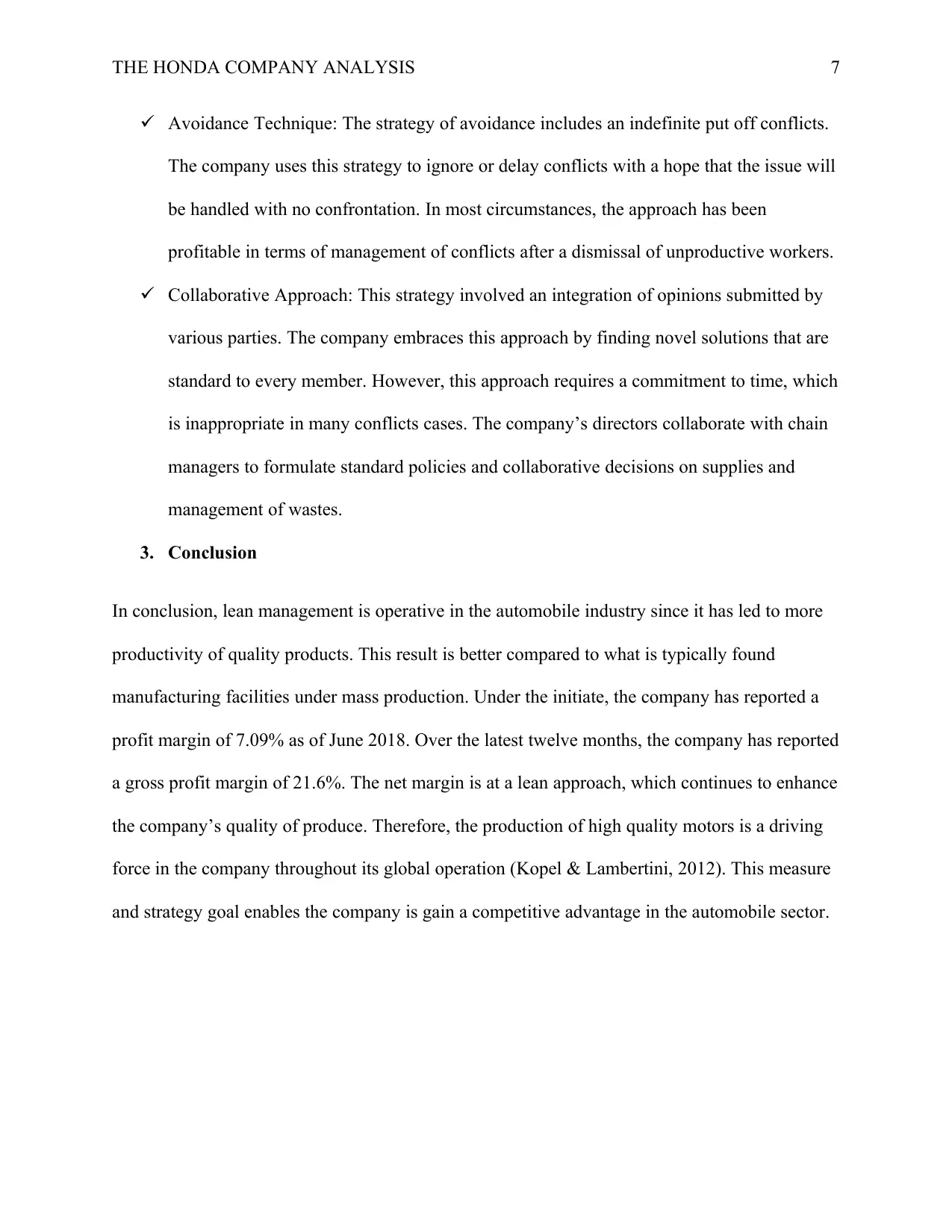
THE HONDA COMPANY ANALYSIS 7
Avoidance Technique: The strategy of avoidance includes an indefinite put off conflicts.
The company uses this strategy to ignore or delay conflicts with a hope that the issue will
be handled with no confrontation. In most circumstances, the approach has been
profitable in terms of management of conflicts after a dismissal of unproductive workers.
Collaborative Approach: This strategy involved an integration of opinions submitted by
various parties. The company embraces this approach by finding novel solutions that are
standard to every member. However, this approach requires a commitment to time, which
is inappropriate in many conflicts cases. The company’s directors collaborate with chain
managers to formulate standard policies and collaborative decisions on supplies and
management of wastes.
3. Conclusion
In conclusion, lean management is operative in the automobile industry since it has led to more
productivity of quality products. This result is better compared to what is typically found
manufacturing facilities under mass production. Under the initiate, the company has reported a
profit margin of 7.09% as of June 2018. Over the latest twelve months, the company has reported
a gross profit margin of 21.6%. The net margin is at a lean approach, which continues to enhance
the company’s quality of produce. Therefore, the production of high quality motors is a driving
force in the company throughout its global operation (Kopel & Lambertini, 2012). This measure
and strategy goal enables the company is gain a competitive advantage in the automobile sector.
Avoidance Technique: The strategy of avoidance includes an indefinite put off conflicts.
The company uses this strategy to ignore or delay conflicts with a hope that the issue will
be handled with no confrontation. In most circumstances, the approach has been
profitable in terms of management of conflicts after a dismissal of unproductive workers.
Collaborative Approach: This strategy involved an integration of opinions submitted by
various parties. The company embraces this approach by finding novel solutions that are
standard to every member. However, this approach requires a commitment to time, which
is inappropriate in many conflicts cases. The company’s directors collaborate with chain
managers to formulate standard policies and collaborative decisions on supplies and
management of wastes.
3. Conclusion
In conclusion, lean management is operative in the automobile industry since it has led to more
productivity of quality products. This result is better compared to what is typically found
manufacturing facilities under mass production. Under the initiate, the company has reported a
profit margin of 7.09% as of June 2018. Over the latest twelve months, the company has reported
a gross profit margin of 21.6%. The net margin is at a lean approach, which continues to enhance
the company’s quality of produce. Therefore, the production of high quality motors is a driving
force in the company throughout its global operation (Kopel & Lambertini, 2012). This measure
and strategy goal enables the company is gain a competitive advantage in the automobile sector.
Paraphrase This Document
Need a fresh take? Get an instant paraphrase of this document with our AI Paraphraser
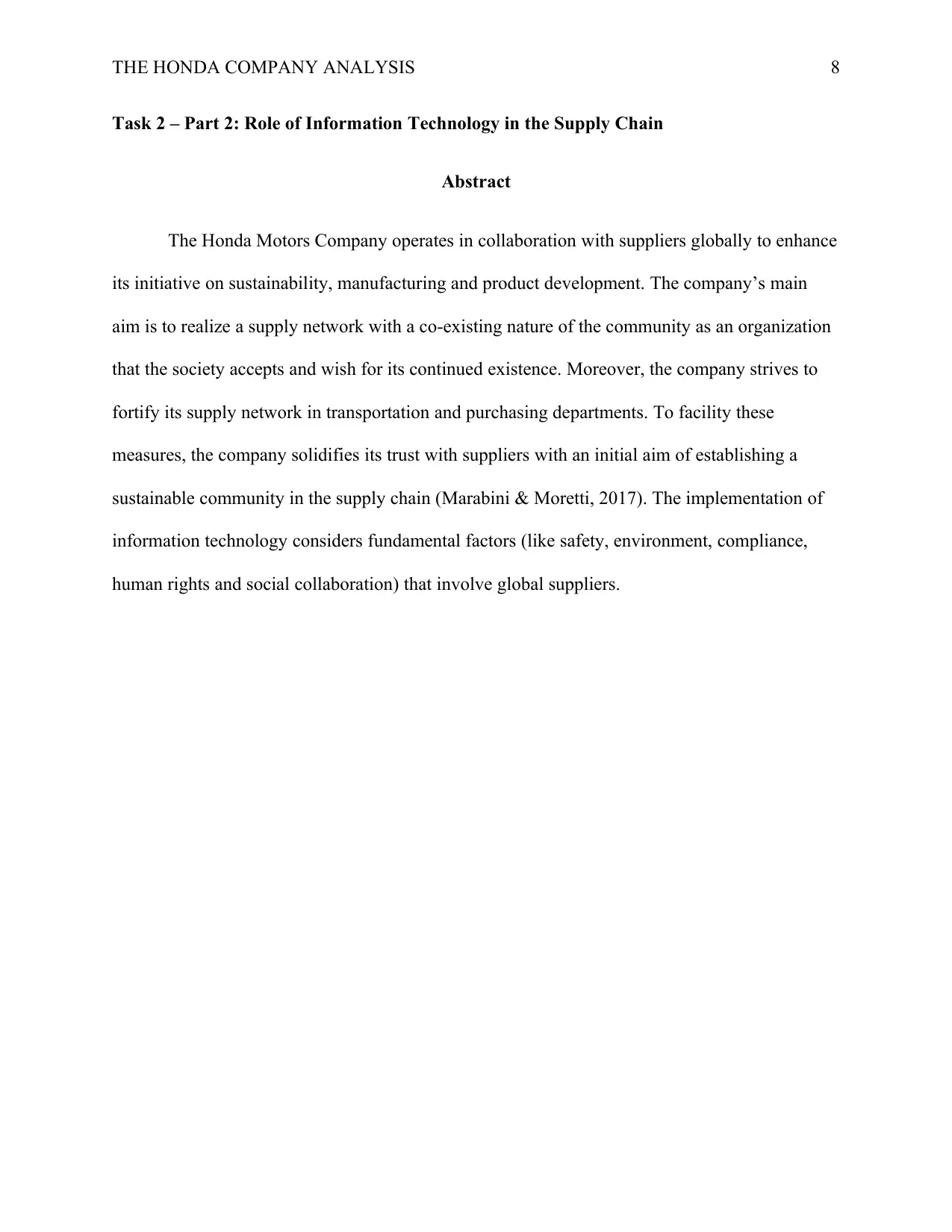
THE HONDA COMPANY ANALYSIS 8
Task 2 – Part 2: Role of Information Technology in the Supply Chain
Abstract
The Honda Motors Company operates in collaboration with suppliers globally to enhance
its initiative on sustainability, manufacturing and product development. The company’s main
aim is to realize a supply network with a co-existing nature of the community as an organization
that the society accepts and wish for its continued existence. Moreover, the company strives to
fortify its supply network in transportation and purchasing departments. To facility these
measures, the company solidifies its trust with suppliers with an initial aim of establishing a
sustainable community in the supply chain (Marabini & Moretti, 2017). The implementation of
information technology considers fundamental factors (like safety, environment, compliance,
human rights and social collaboration) that involve global suppliers.
Task 2 – Part 2: Role of Information Technology in the Supply Chain
Abstract
The Honda Motors Company operates in collaboration with suppliers globally to enhance
its initiative on sustainability, manufacturing and product development. The company’s main
aim is to realize a supply network with a co-existing nature of the community as an organization
that the society accepts and wish for its continued existence. Moreover, the company strives to
fortify its supply network in transportation and purchasing departments. To facility these
measures, the company solidifies its trust with suppliers with an initial aim of establishing a
sustainable community in the supply chain (Marabini & Moretti, 2017). The implementation of
information technology considers fundamental factors (like safety, environment, compliance,
human rights and social collaboration) that involve global suppliers.
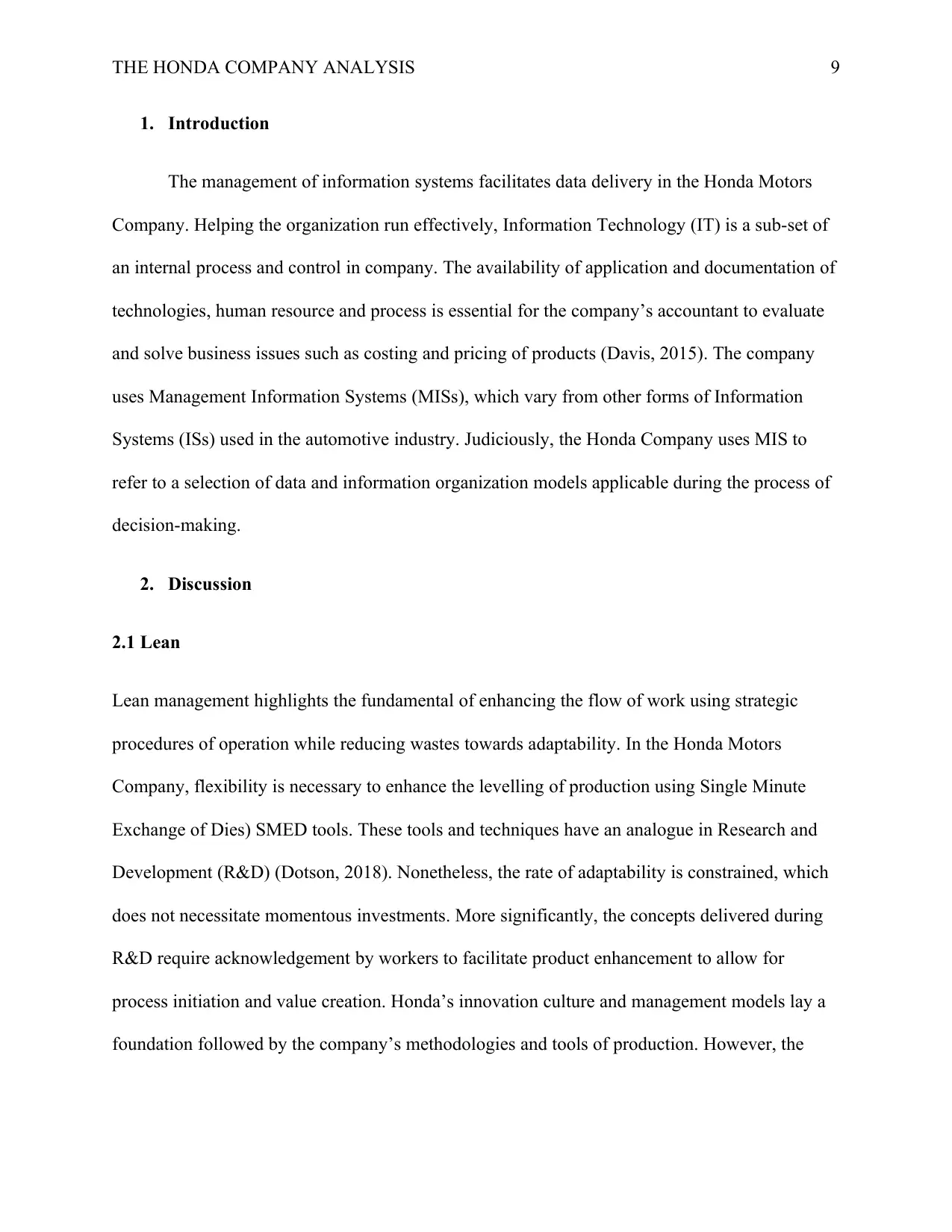
THE HONDA COMPANY ANALYSIS 9
1. Introduction
The management of information systems facilitates data delivery in the Honda Motors
Company. Helping the organization run effectively, Information Technology (IT) is a sub-set of
an internal process and control in company. The availability of application and documentation of
technologies, human resource and process is essential for the company’s accountant to evaluate
and solve business issues such as costing and pricing of products (Davis, 2015). The company
uses Management Information Systems (MISs), which vary from other forms of Information
Systems (ISs) used in the automotive industry. Judiciously, the Honda Company uses MIS to
refer to a selection of data and information organization models applicable during the process of
decision-making.
2. Discussion
2.1 Lean
Lean management highlights the fundamental of enhancing the flow of work using strategic
procedures of operation while reducing wastes towards adaptability. In the Honda Motors
Company, flexibility is necessary to enhance the levelling of production using Single Minute
Exchange of Dies) SMED tools. These tools and techniques have an analogue in Research and
Development (R&D) (Dotson, 2018). Nonetheless, the rate of adaptability is constrained, which
does not necessitate momentous investments. More significantly, the concepts delivered during
R&D require acknowledgement by workers to facilitate product enhancement to allow for
process initiation and value creation. Honda’s innovation culture and management models lay a
foundation followed by the company’s methodologies and tools of production. However, the
1. Introduction
The management of information systems facilitates data delivery in the Honda Motors
Company. Helping the organization run effectively, Information Technology (IT) is a sub-set of
an internal process and control in company. The availability of application and documentation of
technologies, human resource and process is essential for the company’s accountant to evaluate
and solve business issues such as costing and pricing of products (Davis, 2015). The company
uses Management Information Systems (MISs), which vary from other forms of Information
Systems (ISs) used in the automotive industry. Judiciously, the Honda Company uses MIS to
refer to a selection of data and information organization models applicable during the process of
decision-making.
2. Discussion
2.1 Lean
Lean management highlights the fundamental of enhancing the flow of work using strategic
procedures of operation while reducing wastes towards adaptability. In the Honda Motors
Company, flexibility is necessary to enhance the levelling of production using Single Minute
Exchange of Dies) SMED tools. These tools and techniques have an analogue in Research and
Development (R&D) (Dotson, 2018). Nonetheless, the rate of adaptability is constrained, which
does not necessitate momentous investments. More significantly, the concepts delivered during
R&D require acknowledgement by workers to facilitate product enhancement to allow for
process initiation and value creation. Honda’s innovation culture and management models lay a
foundation followed by the company’s methodologies and tools of production. However, the
⊘ This is a preview!⊘
Do you want full access?
Subscribe today to unlock all pages.

Trusted by 1+ million students worldwide
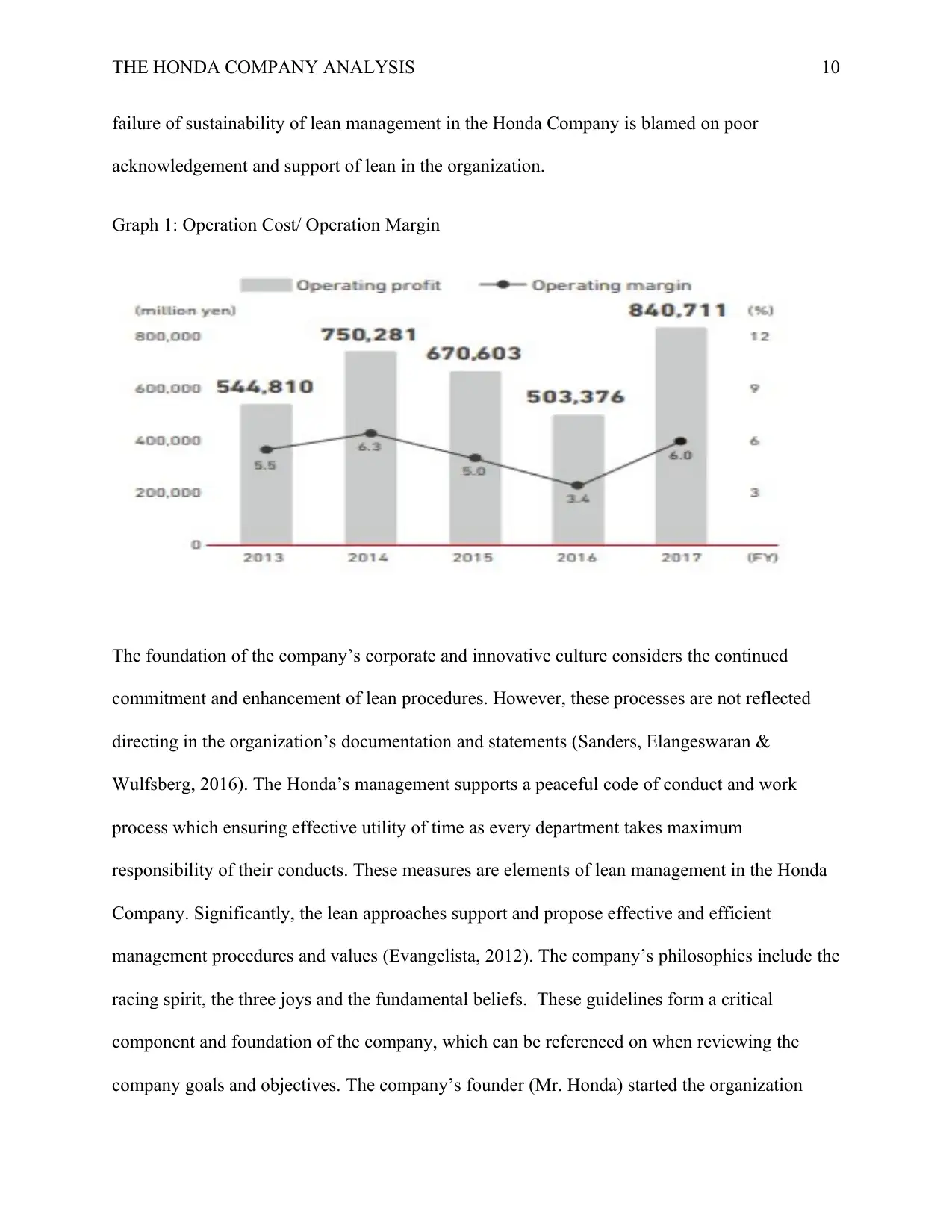
THE HONDA COMPANY ANALYSIS 10
failure of sustainability of lean management in the Honda Company is blamed on poor
acknowledgement and support of lean in the organization.
Graph 1: Operation Cost/ Operation Margin
The foundation of the company’s corporate and innovative culture considers the continued
commitment and enhancement of lean procedures. However, these processes are not reflected
directing in the organization’s documentation and statements (Sanders, Elangeswaran &
Wulfsberg, 2016). The Honda’s management supports a peaceful code of conduct and work
process which ensuring effective utility of time as every department takes maximum
responsibility of their conducts. These measures are elements of lean management in the Honda
Company. Significantly, the lean approaches support and propose effective and efficient
management procedures and values (Evangelista, 2012). The company’s philosophies include the
racing spirit, the three joys and the fundamental beliefs. These guidelines form a critical
component and foundation of the company, which can be referenced on when reviewing the
company goals and objectives. The company’s founder (Mr. Honda) started the organization
failure of sustainability of lean management in the Honda Company is blamed on poor
acknowledgement and support of lean in the organization.
Graph 1: Operation Cost/ Operation Margin
The foundation of the company’s corporate and innovative culture considers the continued
commitment and enhancement of lean procedures. However, these processes are not reflected
directing in the organization’s documentation and statements (Sanders, Elangeswaran &
Wulfsberg, 2016). The Honda’s management supports a peaceful code of conduct and work
process which ensuring effective utility of time as every department takes maximum
responsibility of their conducts. These measures are elements of lean management in the Honda
Company. Significantly, the lean approaches support and propose effective and efficient
management procedures and values (Evangelista, 2012). The company’s philosophies include the
racing spirit, the three joys and the fundamental beliefs. These guidelines form a critical
component and foundation of the company, which can be referenced on when reviewing the
company goals and objectives. The company’s founder (Mr. Honda) started the organization
Paraphrase This Document
Need a fresh take? Get an instant paraphrase of this document with our AI Paraphraser
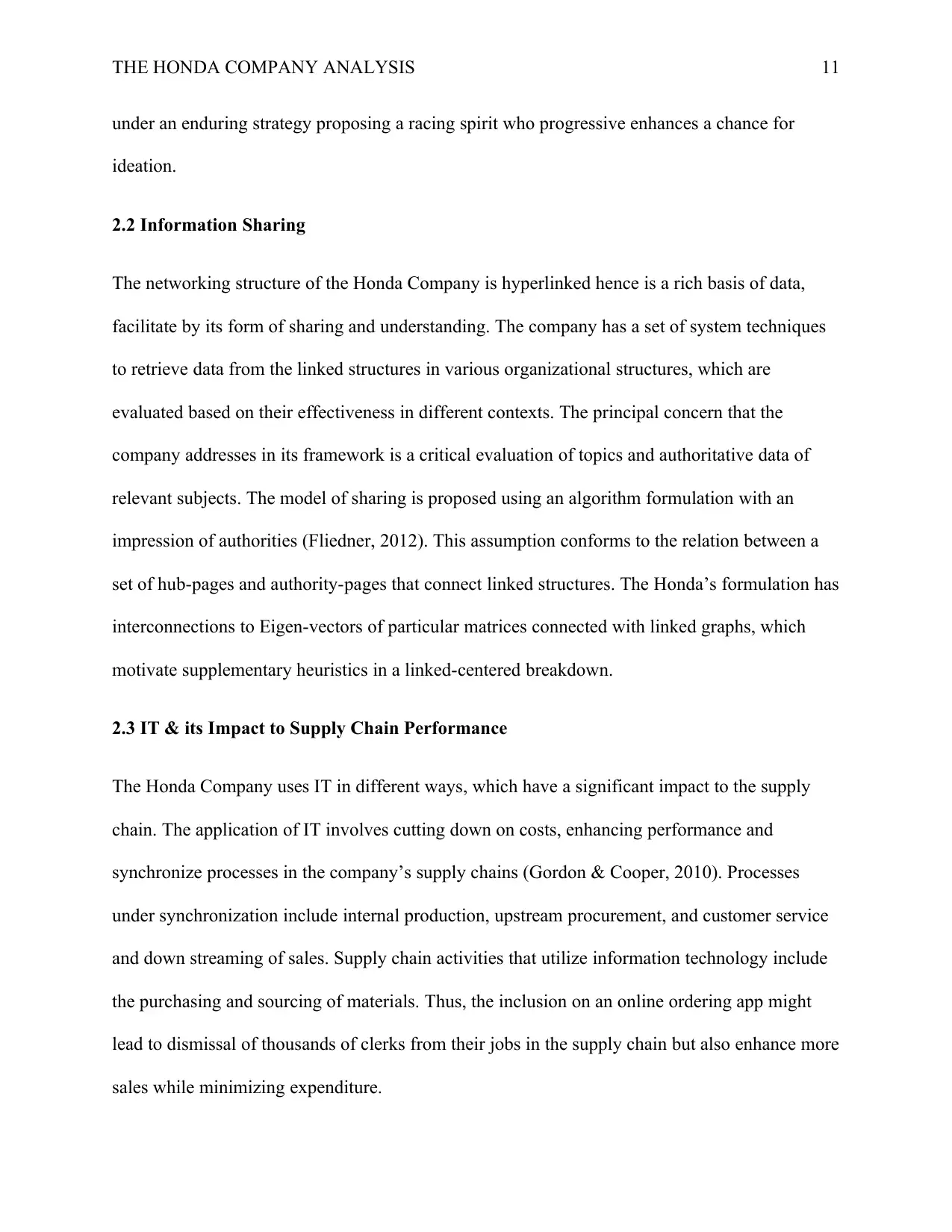
THE HONDA COMPANY ANALYSIS 11
under an enduring strategy proposing a racing spirit who progressive enhances a chance for
ideation.
2.2 Information Sharing
The networking structure of the Honda Company is hyperlinked hence is a rich basis of data,
facilitate by its form of sharing and understanding. The company has a set of system techniques
to retrieve data from the linked structures in various organizational structures, which are
evaluated based on their effectiveness in different contexts. The principal concern that the
company addresses in its framework is a critical evaluation of topics and authoritative data of
relevant subjects. The model of sharing is proposed using an algorithm formulation with an
impression of authorities (Fliedner, 2012). This assumption conforms to the relation between a
set of hub-pages and authority-pages that connect linked structures. The Honda’s formulation has
interconnections to Eigen-vectors of particular matrices connected with linked graphs, which
motivate supplementary heuristics in a linked-centered breakdown.
2.3 IT & its Impact to Supply Chain Performance
The Honda Company uses IT in different ways, which have a significant impact to the supply
chain. The application of IT involves cutting down on costs, enhancing performance and
synchronize processes in the company’s supply chains (Gordon & Cooper, 2010). Processes
under synchronization include internal production, upstream procurement, and customer service
and down streaming of sales. Supply chain activities that utilize information technology include
the purchasing and sourcing of materials. Thus, the inclusion on an online ordering app might
lead to dismissal of thousands of clerks from their jobs in the supply chain but also enhance more
sales while minimizing expenditure.
under an enduring strategy proposing a racing spirit who progressive enhances a chance for
ideation.
2.2 Information Sharing
The networking structure of the Honda Company is hyperlinked hence is a rich basis of data,
facilitate by its form of sharing and understanding. The company has a set of system techniques
to retrieve data from the linked structures in various organizational structures, which are
evaluated based on their effectiveness in different contexts. The principal concern that the
company addresses in its framework is a critical evaluation of topics and authoritative data of
relevant subjects. The model of sharing is proposed using an algorithm formulation with an
impression of authorities (Fliedner, 2012). This assumption conforms to the relation between a
set of hub-pages and authority-pages that connect linked structures. The Honda’s formulation has
interconnections to Eigen-vectors of particular matrices connected with linked graphs, which
motivate supplementary heuristics in a linked-centered breakdown.
2.3 IT & its Impact to Supply Chain Performance
The Honda Company uses IT in different ways, which have a significant impact to the supply
chain. The application of IT involves cutting down on costs, enhancing performance and
synchronize processes in the company’s supply chains (Gordon & Cooper, 2010). Processes
under synchronization include internal production, upstream procurement, and customer service
and down streaming of sales. Supply chain activities that utilize information technology include
the purchasing and sourcing of materials. Thus, the inclusion on an online ordering app might
lead to dismissal of thousands of clerks from their jobs in the supply chain but also enhance more
sales while minimizing expenditure.
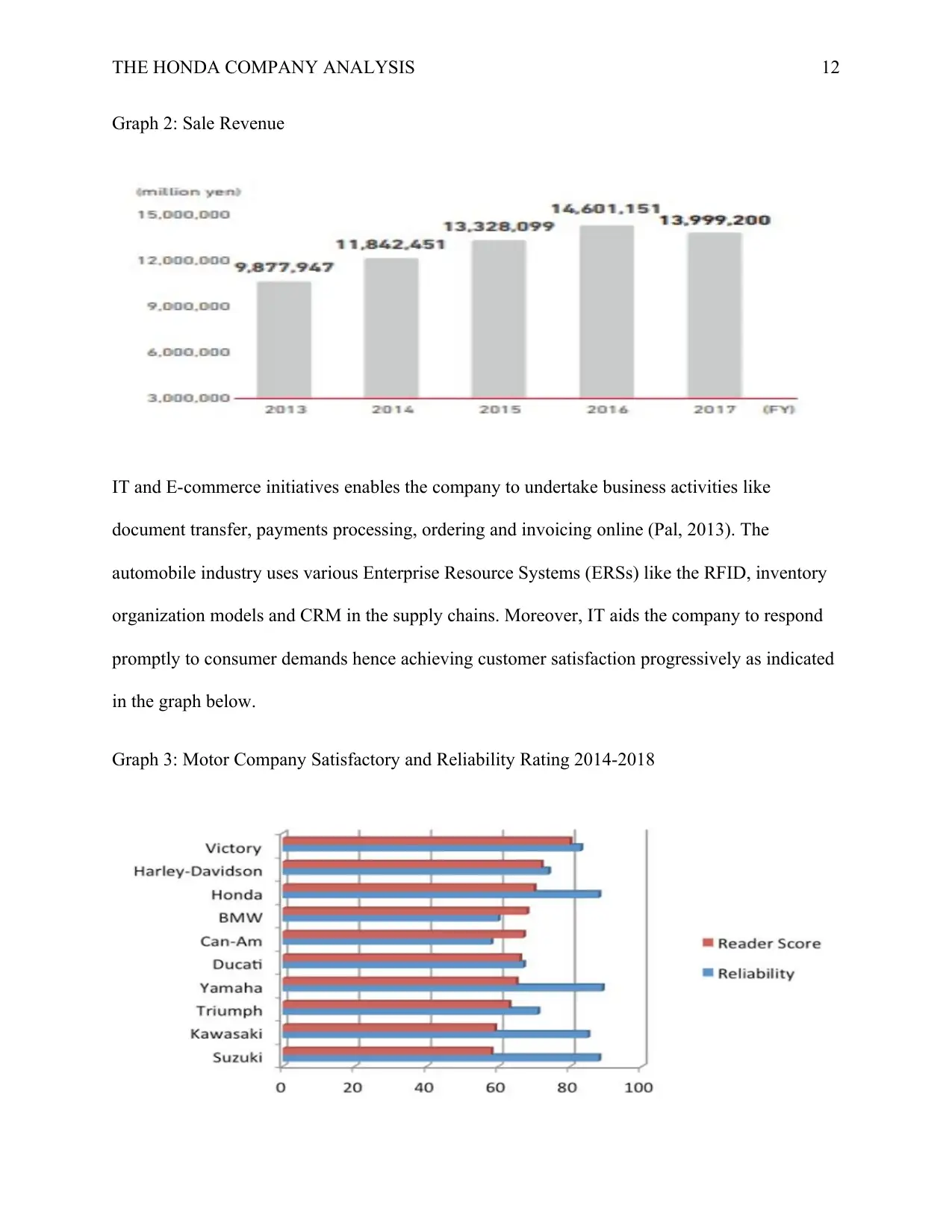
THE HONDA COMPANY ANALYSIS 12
Graph 2: Sale Revenue
IT and E-commerce initiatives enables the company to undertake business activities like
document transfer, payments processing, ordering and invoicing online (Pal, 2013). The
automobile industry uses various Enterprise Resource Systems (ERSs) like the RFID, inventory
organization models and CRM in the supply chains. Moreover, IT aids the company to respond
promptly to consumer demands hence achieving customer satisfaction progressively as indicated
in the graph below.
Graph 3: Motor Company Satisfactory and Reliability Rating 2014-2018
Graph 2: Sale Revenue
IT and E-commerce initiatives enables the company to undertake business activities like
document transfer, payments processing, ordering and invoicing online (Pal, 2013). The
automobile industry uses various Enterprise Resource Systems (ERSs) like the RFID, inventory
organization models and CRM in the supply chains. Moreover, IT aids the company to respond
promptly to consumer demands hence achieving customer satisfaction progressively as indicated
in the graph below.
Graph 3: Motor Company Satisfactory and Reliability Rating 2014-2018
⊘ This is a preview!⊘
Do you want full access?
Subscribe today to unlock all pages.

Trusted by 1+ million students worldwide
1 out of 19
Related Documents
Your All-in-One AI-Powered Toolkit for Academic Success.
+13062052269
info@desklib.com
Available 24*7 on WhatsApp / Email
![[object Object]](/_next/static/media/star-bottom.7253800d.svg)
Unlock your academic potential
Copyright © 2020–2025 A2Z Services. All Rights Reserved. Developed and managed by ZUCOL.




